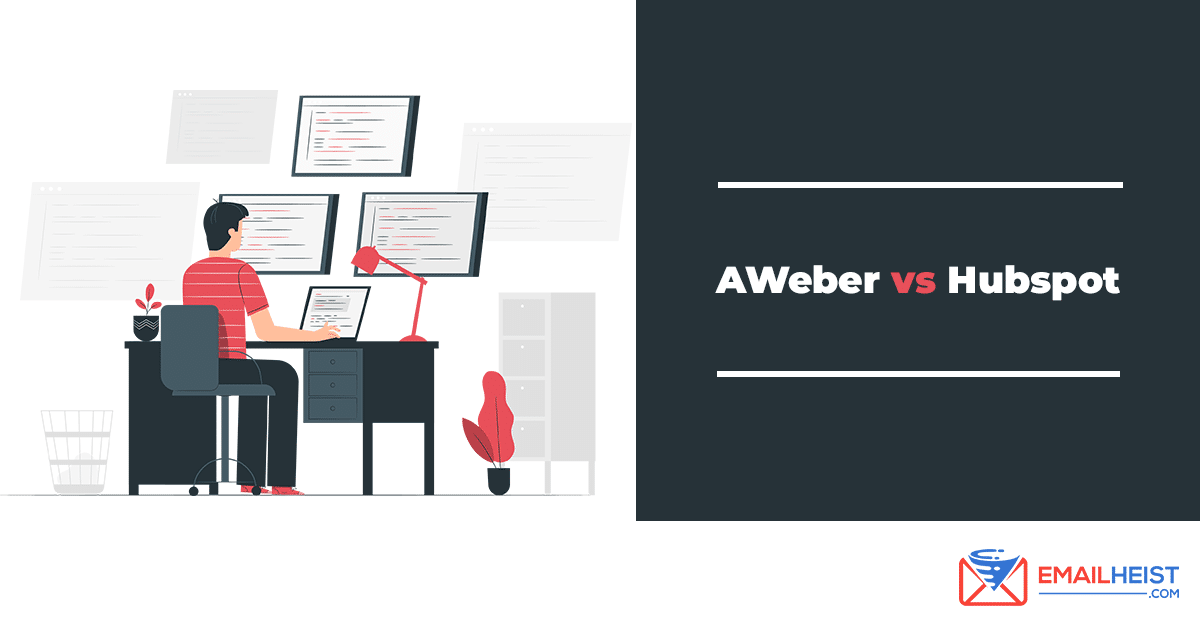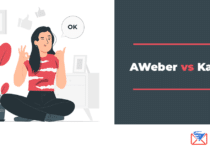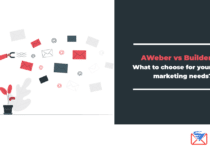AWeber vs HubSpot: Which is the better marketing tool?

AWeber vs HubSpot is an apples vs oranges situation. Though both marketing softwares, AWeber is an email marketing application while HubSpot is an all-in-one marketing platform. AWeber is focused on helping you build a relationship with your audience or contacts better while HubSpot is more focused on helping your business grow.
In this article, we look into the marketing features of both AWeber and HubSpot and compare them to find out which is the better investment for your money.
Get our FREE course on AFFILIATE MARKETING straight to your inbox This course includes video tutorials on how to do email marketing.![]()
The Origin
AWeber
Compared to Hubspot, AWeber has been around longer – over 20 years.
Tom Kulzer founded AWeber in 1998 with the aim of reinventing how email marketing works—focused on assisting the starter business at that time.
Known as one of the earliest software to serve such an offer, the program gained easy early exposure.
AWeber now assists with the email marketing campaigns of more than 100,000 businesses worldwide. Their main headquarters is in Northeastern, US and consists of workers around the globe, working remotely. (READ: What is AWeber? Everything you need to know)
HubSpot
A newer face in the scene, HubSpot was founded by Brian Halligan and Dharmesh Shah in 2006, and was first aimed at small businesses. In the next five years, they upgraded their target audience to larger companies.
Today, HubSpot caters to over 100,000 customers in 120 countries.
A Good Marketing Software: The Must-Haves
Subscribing to a program means investing in it as well. Before you make that investment, check if the software application you’re considering has the following factors:
- Customizable Elements
- Deliverability Rate & Accuracy
- Analytics and Data Reporting
- Different Email Marketing Campaigns
- Social Media Advertisement
- Customer Relations Management
- Web Contents Management
- Marketing Automation
- Basic yet Powerful User Interface/Experience
- Affordable Price Ranges
- Accommodating Support Team/Group
Functions & Utilities: Battle of the marketing tools
AWeber
AWeber focuses on Marketing & Advertising.
- Email Customization – Design your email content.
o Smart Designer – Use AI to stylize your emails based on your tastes.
o Drag-n-Drop Customize Builder – personalize pre-made templates with ease.
- Landing Page Builder – Create squeeze pages to direct your customers. Compel other users by making informative pages.
- Auto-Newsletters – Inform your contacts about new blog posts, automatically send updates thru messages.
- Autoresponders – set mail triggers to respond/deliver automatically. Manage contacts easily by setting conditions per mails.
- Automation Workflows (Email Marketing Automation)
o Build a workflow that consists of sequences for successful conversion.
- Automate Tagging – quickly identify contacts by categorization.
- Email Campaign Starter – Send out bulk email campaigns to gain exposure.
o Campaign Tracker – Track the current status of your campaigns.
- Reports Dashboard – covers the vital info and data regarding your business. It’ll include important information, such as behavior and sales.
- AWeber Mobile App (Both the Main and Stats App)
o Manage your business on the go. Wherever you may be, use the app to check out the current status, hassle-free.
- Split Testing (A/B Split Testing) – Use this for your emails. Build and Compare two emails based on their performance. Effective mail will be your initial campaign.
- Subscriber Management – Segregate and exclude contacts that matter. Easily manage your priorities by dividing what’s necessary.
- List & Target Segmentation – Pick and decide on your primary audience. Not everyone’s going to love what you offer. So pick a niche and a general demographic.
- Integrations – External contacts? No worries, AWeber allows importation/exportation from outside sources.
HubSpot
Hubspot has different platforms with separate functions. Today, we’ll be focusing on the main products (Hubspot CRM & Sales).
HUBSPOT MARKETING
- Marketing Automation – Easily process transactions with processed steps. Guide customers to a specific flow so that conversion can be done faster.
- Blog Builder – Upload daily news and post in your blogs. Use this to strengthen contact connections.
o Call-to-Actions – Pop Ups that can persuade onlookers to join. Design your own CTA to expose your merch.
- Search Engine Optimization – Improve your web traffic by adding your site to search engines—easy exposure with just a click. Unpaid traffic can help increase sales & attention.
- Social Media Management – Use Hubspot to gain revenue from social media ads. Track, monitor, and publish pop-ups to persuade potential customers.
o Social Media Monitoring
o Social Media Analytics
o Social Media Publishing
- Live Convo with Customers – Conduct online sessions with your contacts. Engage through forums or webinars that’ll help your connections grow.
HUBSPOT CRM
- Landing Page Builder – Build your own domain/page with ease. Choose mobile-optimized templates, customize based on your choosing.
- Form Builder – Sign-ups are great for recruits. Create forms that’ll auto pop-up on your pages.
- Account-Based Marketing – Conduct 1-on-1 consultations with potential buyers. Engage with them until your connection is nurtured. Who knows, they might come back to buy more.
- Lead Tracking & Management – Personally, check your contacts status. Insightful data like this can be great for retargeting.
- Salesforce Integration – Connect your eCommerce accounts to your Hubspot site. That way, you can overlook each payment. Each successful payment will be recorded.
Since both are adept in sales and management,a specific situation calls for accurate solutions. Both AWeber and HubSpot have lots of features to offer, and it really is up to a user to decide which functions they could use the most.
Target Audience
As we’ve seen from the overview of tools, it’s clear that both programs are made for a specific target and its entrepreneurs. Both programs are developed for a single purpose: to assist entrepreneurs, regardless of size, to be successful.
All of these entrepreneurs could benefit the most from using AWeber and HubSpot:
- Freelancers / Independent Businesses
- Content Creators / Vloggers / Bloggers
- Retailers / Small Businesses
- Online or Actual Services
- Promoters or Sales Head
- Huge Brands
Price Comparison: Expense Plans
Both programs have great price options. AWeber offers a contact-based payment, where the number of contacts will decide the price.
Hubspot, however, has free plans for CRM and Sales Basic. Keep in mind that free plans only have the basic tools as usual.
In AWeber, you can use Free Forever. This can only happen if you don’t pass 500 contacts. If you do, you’ll be fined $19/mo. This plan comes with minimum features.
While in Hubspot, Free CRM and Sales tools are provided. The only drawback is that some features are limited.
If users wish to upgrade Hubspot’s subscription, they’ll have to pay $200/mo (billed annually). It was a pretty hefty price for a beginner-level user.
But it covers the necessities. AWeber only adds $10-15/mo if you’ve reached 2,500 contacts. A great deal if you need a simple solution.
But if these aren’t enough, you can test both programs yourself since they both offer Free Trials.
Hubspot is a good tool, it’s social media and email marketing features will especially benefit bigger companies who are focused on growth.
Meanwhile, we think AWeber is an excellent tool especially for beginners and smaller businesses. Having been around for a while, it has history to back up its performance and efficiency. On its website, it claims to help you “build a stronger connection with your audience,” and when used right, it lives up to its claim. On top of that, we think it’s fairly priced.


